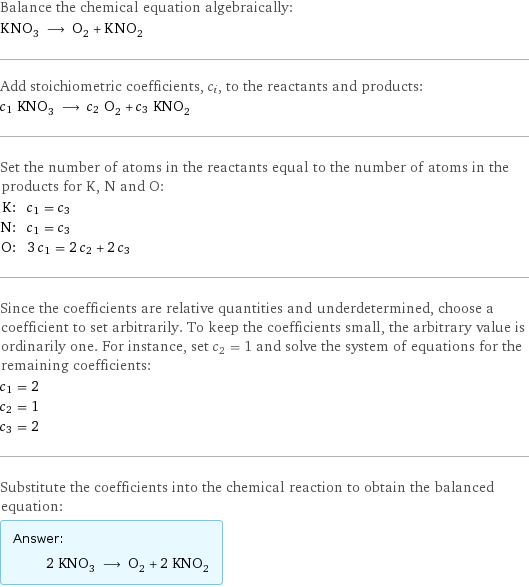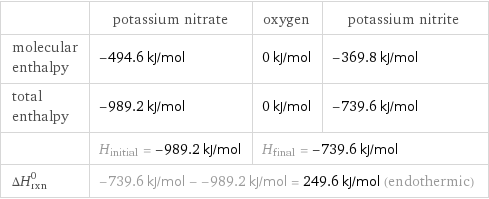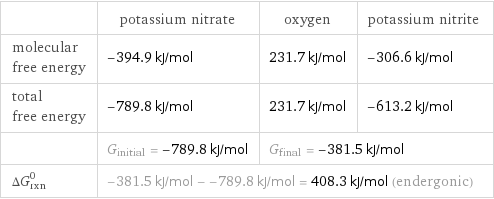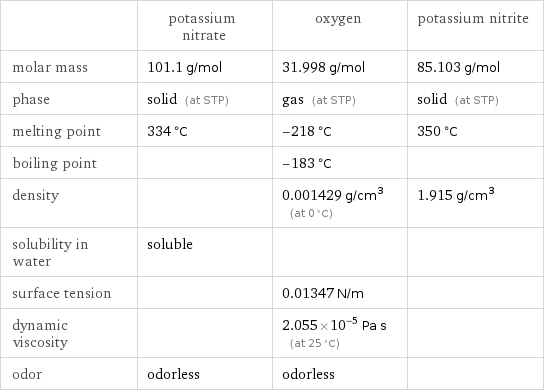Input interpretation

KNO_3 (potassium nitrate) ⟶ O_2 (oxygen) + KNO_2 (potassium nitrite)
Balanced equation

Balance the chemical equation algebraically: KNO_3 ⟶ O_2 + KNO_2 Add stoichiometric coefficients, c_i, to the reactants and products: c_1 KNO_3 ⟶ c_2 O_2 + c_3 KNO_2 Set the number of atoms in the reactants equal to the number of atoms in the products for K, N and O: K: | c_1 = c_3 N: | c_1 = c_3 O: | 3 c_1 = 2 c_2 + 2 c_3 Since the coefficients are relative quantities and underdetermined, choose a coefficient to set arbitrarily. To keep the coefficients small, the arbitrary value is ordinarily one. For instance, set c_2 = 1 and solve the system of equations for the remaining coefficients: c_1 = 2 c_2 = 1 c_3 = 2 Substitute the coefficients into the chemical reaction to obtain the balanced equation: Answer: | | 2 KNO_3 ⟶ O_2 + 2 KNO_2
Structures

⟶ +
Names

potassium nitrate ⟶ oxygen + potassium nitrite
Reaction thermodynamics
Enthalpy

| potassium nitrate | oxygen | potassium nitrite molecular enthalpy | -494.6 kJ/mol | 0 kJ/mol | -369.8 kJ/mol total enthalpy | -989.2 kJ/mol | 0 kJ/mol | -739.6 kJ/mol | H_initial = -989.2 kJ/mol | H_final = -739.6 kJ/mol | ΔH_rxn^0 | -739.6 kJ/mol - -989.2 kJ/mol = 249.6 kJ/mol (endothermic) | |
Gibbs free energy

| potassium nitrate | oxygen | potassium nitrite molecular free energy | -394.9 kJ/mol | 231.7 kJ/mol | -306.6 kJ/mol total free energy | -789.8 kJ/mol | 231.7 kJ/mol | -613.2 kJ/mol | G_initial = -789.8 kJ/mol | G_final = -381.5 kJ/mol | ΔG_rxn^0 | -381.5 kJ/mol - -789.8 kJ/mol = 408.3 kJ/mol (endergonic) | |
Equilibrium constant
![Construct the equilibrium constant, K, expression for: KNO_3 ⟶ O_2 + KNO_2 Plan: • Balance the chemical equation. • Determine the stoichiometric numbers. • Assemble the activity expression for each chemical species. • Use the activity expressions to build the equilibrium constant expression. Write the balanced chemical equation: 2 KNO_3 ⟶ O_2 + 2 KNO_2 Assign stoichiometric numbers, ν_i, using the stoichiometric coefficients, c_i, from the balanced chemical equation in the following manner: ν_i = -c_i for reactants and ν_i = c_i for products: chemical species | c_i | ν_i KNO_3 | 2 | -2 O_2 | 1 | 1 KNO_2 | 2 | 2 Assemble the activity expressions accounting for the state of matter and ν_i: chemical species | c_i | ν_i | activity expression KNO_3 | 2 | -2 | ([KNO3])^(-2) O_2 | 1 | 1 | [O2] KNO_2 | 2 | 2 | ([KNO2])^2 The equilibrium constant symbol in the concentration basis is: K_c Mulitply the activity expressions to arrive at the K_c expression: Answer: | | K_c = ([KNO3])^(-2) [O2] ([KNO2])^2 = ([O2] ([KNO2])^2)/([KNO3])^2](../image_source/a82e5a5bc989a2d964ee8b211ffef19c.png)
Construct the equilibrium constant, K, expression for: KNO_3 ⟶ O_2 + KNO_2 Plan: • Balance the chemical equation. • Determine the stoichiometric numbers. • Assemble the activity expression for each chemical species. • Use the activity expressions to build the equilibrium constant expression. Write the balanced chemical equation: 2 KNO_3 ⟶ O_2 + 2 KNO_2 Assign stoichiometric numbers, ν_i, using the stoichiometric coefficients, c_i, from the balanced chemical equation in the following manner: ν_i = -c_i for reactants and ν_i = c_i for products: chemical species | c_i | ν_i KNO_3 | 2 | -2 O_2 | 1 | 1 KNO_2 | 2 | 2 Assemble the activity expressions accounting for the state of matter and ν_i: chemical species | c_i | ν_i | activity expression KNO_3 | 2 | -2 | ([KNO3])^(-2) O_2 | 1 | 1 | [O2] KNO_2 | 2 | 2 | ([KNO2])^2 The equilibrium constant symbol in the concentration basis is: K_c Mulitply the activity expressions to arrive at the K_c expression: Answer: | | K_c = ([KNO3])^(-2) [O2] ([KNO2])^2 = ([O2] ([KNO2])^2)/([KNO3])^2
Rate of reaction
![Construct the rate of reaction expression for: KNO_3 ⟶ O_2 + KNO_2 Plan: • Balance the chemical equation. • Determine the stoichiometric numbers. • Assemble the rate term for each chemical species. • Write the rate of reaction expression. Write the balanced chemical equation: 2 KNO_3 ⟶ O_2 + 2 KNO_2 Assign stoichiometric numbers, ν_i, using the stoichiometric coefficients, c_i, from the balanced chemical equation in the following manner: ν_i = -c_i for reactants and ν_i = c_i for products: chemical species | c_i | ν_i KNO_3 | 2 | -2 O_2 | 1 | 1 KNO_2 | 2 | 2 The rate term for each chemical species, B_i, is 1/ν_i(Δ[B_i])/(Δt) where [B_i] is the amount concentration and t is time: chemical species | c_i | ν_i | rate term KNO_3 | 2 | -2 | -1/2 (Δ[KNO3])/(Δt) O_2 | 1 | 1 | (Δ[O2])/(Δt) KNO_2 | 2 | 2 | 1/2 (Δ[KNO2])/(Δt) (for infinitesimal rate of change, replace Δ with d) Set the rate terms equal to each other to arrive at the rate expression: Answer: | | rate = -1/2 (Δ[KNO3])/(Δt) = (Δ[O2])/(Δt) = 1/2 (Δ[KNO2])/(Δt) (assuming constant volume and no accumulation of intermediates or side products)](../image_source/ffa088838ae44b02d42264d6cf336f59.png)
Construct the rate of reaction expression for: KNO_3 ⟶ O_2 + KNO_2 Plan: • Balance the chemical equation. • Determine the stoichiometric numbers. • Assemble the rate term for each chemical species. • Write the rate of reaction expression. Write the balanced chemical equation: 2 KNO_3 ⟶ O_2 + 2 KNO_2 Assign stoichiometric numbers, ν_i, using the stoichiometric coefficients, c_i, from the balanced chemical equation in the following manner: ν_i = -c_i for reactants and ν_i = c_i for products: chemical species | c_i | ν_i KNO_3 | 2 | -2 O_2 | 1 | 1 KNO_2 | 2 | 2 The rate term for each chemical species, B_i, is 1/ν_i(Δ[B_i])/(Δt) where [B_i] is the amount concentration and t is time: chemical species | c_i | ν_i | rate term KNO_3 | 2 | -2 | -1/2 (Δ[KNO3])/(Δt) O_2 | 1 | 1 | (Δ[O2])/(Δt) KNO_2 | 2 | 2 | 1/2 (Δ[KNO2])/(Δt) (for infinitesimal rate of change, replace Δ with d) Set the rate terms equal to each other to arrive at the rate expression: Answer: | | rate = -1/2 (Δ[KNO3])/(Δt) = (Δ[O2])/(Δt) = 1/2 (Δ[KNO2])/(Δt) (assuming constant volume and no accumulation of intermediates or side products)
Chemical names and formulas

| potassium nitrate | oxygen | potassium nitrite formula | KNO_3 | O_2 | KNO_2 name | potassium nitrate | oxygen | potassium nitrite IUPAC name | potassium nitrate | molecular oxygen | potassium nitrite
Substance properties

| potassium nitrate | oxygen | potassium nitrite molar mass | 101.1 g/mol | 31.998 g/mol | 85.103 g/mol phase | solid (at STP) | gas (at STP) | solid (at STP) melting point | 334 °C | -218 °C | 350 °C boiling point | | -183 °C | density | | 0.001429 g/cm^3 (at 0 °C) | 1.915 g/cm^3 solubility in water | soluble | | surface tension | | 0.01347 N/m | dynamic viscosity | | 2.055×10^-5 Pa s (at 25 °C) | odor | odorless | odorless |
Units
